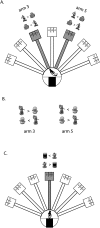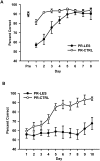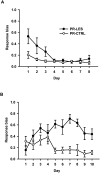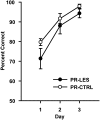Perirhinal cortex is necessary for acquiring, but not for retrieving object-place paired association
- PMID: 20154355
- PMCID: PMC2825694
- DOI: 10.1101/lm.1620410
Perirhinal cortex is necessary for acquiring, but not for retrieving object-place paired association
Abstract
Remembering events frequently involves associating objects and their associated locations in space, and it has been implicated that the areas associated with the hippocampus are important in this function. The current study examined the role of the perirhinal cortex in retrieving familiar object-place paired associates, as well as in acquiring novel ones. Rats were required to visit one of two locations of a radial-arm maze and choose one of the objects (from a pair of different toy objects) exclusively associated with a given arm. Excitotoxic lesions of the perirhinal cortex initially impaired the normal retrieval of object-place paired-associative memories that had been learned presurgically, but the animals relearned gradually to the level of controls. In contrast, when required to associate a novel pair of objects with the same locations of the maze, the same lesioned rats were severely impaired with minimal learning, if any, taking place throughout an extensive testing period. However, the lesioned rats were normal in discriminating two different objects presented in a fixed arm in the maze. The results suggest that the perirhinal cortex is indispensable to forming discrete representations for object-place paired associates. Its role, however, may be compensated for by other structures when familiar object-place paired associative memories need to be retrieved.
Figures






Similar articles
-
Dentate gyrus is necessary for disambiguating similar object-place representations.Learn Mem. 2010 Apr 26;17(5):252-8. doi: 10.1101/lm.1678210. Print 2010 May. Learn Mem. 2010. PMID: 20421312 Free PMC article.
-
Disconnection of the hippocampal-perirhinal cortical circuits severely disrupts object-place paired associative memory.J Neurosci. 2010 Jul 21;30(29):9850-8. doi: 10.1523/JNEUROSCI.1580-10.2010. J Neurosci. 2010. PMID: 20660267 Free PMC article.
-
Hippocampus is required for paired associate memory with neither delay nor trial uniqueness.Learn Mem. 2011 Dec 14;19(1):1-8. doi: 10.1101/lm.024554.111. Print 2012 Jan. Learn Mem. 2011. PMID: 22174309 Free PMC article.
-
Role of perirhinal cortex in object perception, memory, and associations.Curr Opin Neurobiol. 2001 Apr;11(2):188-93. doi: 10.1016/s0959-4388(00)00195-1. Curr Opin Neurobiol. 2001. PMID: 11301238 Review.
-
Perirhinal cortex ablation impairs visual object identification.J Neurosci. 1998 Mar 15;18(6):2268-75. doi: 10.1523/JNEUROSCI.18-06-02268.1998. J Neurosci. 1998. PMID: 9482811 Free PMC article. Review.
Cited by
-
Moderate prenatal alcohol exposure impairs performance by adult male rats in an object-place paired-associate task.Behav Brain Res. 2019 Mar 15;360:228-234. doi: 10.1016/j.bbr.2018.12.014. Epub 2018 Dec 7. Behav Brain Res. 2019. PMID: 30529401 Free PMC article.
-
Contextual behavior and neural circuits.Front Neural Circuits. 2013 May 10;7:84. doi: 10.3389/fncir.2013.00084. eCollection 2013. Front Neural Circuits. 2013. PMID: 23675321 Free PMC article. Review.
-
Perirhinal cortical inactivation impairs object-in-place memory and disrupts task-dependent firing in hippocampal CA1, but not in CA3.Front Neural Circuits. 2013 Aug 14;7:134. doi: 10.3389/fncir.2013.00134. eCollection 2013. Front Neural Circuits. 2013. PMID: 23966912 Free PMC article.
-
Reconciling the object and spatial processing views of the perirhinal cortex through task-relevant unitization.Hippocampus. 2021 Jul;31(7):737-755. doi: 10.1002/hipo.23304. Epub 2021 Feb 1. Hippocampus. 2021. PMID: 33523577 Free PMC article. Review.
-
Neural correlates of object-in-place learning in hippocampus and prefrontal cortex.J Neurosci. 2011 Nov 23;31(47):16991-7006. doi: 10.1523/JNEUROSCI.2859-11.2011. J Neurosci. 2011. PMID: 22114269 Free PMC article.
References
-
- Abe H, Ishida Y, Nonaka H, Iwasaki T. Functional difference between rat perirhinal cortex and hippocampus in object and place discrimination tasks. Behav Brain Res. 2008;197:388–397. - PubMed
-
- Aggleton JP, Brown MW. Episodic memory, amnesia, and the hippocampal-anterior thalamic axis. Behav Brain Sci. 1999;22:425–489. - PubMed
-
- Aggleton JP, Hunt PR, Rawlins JN. The effects of hippocampal lesions upon spatial and non-spatial tests of working memory. Behav Brain Res. 1986;19:133–146. - PubMed
-
- Bachevalier J, Nemanic S. Memory for spatial location and object-place associations are differently processed by the hippocampal formation, parahippocampal areas TH/TF and perirhinal cortex. Hippocampus. 2008;18:64–80. - PubMed
Publication types
MeSH terms
Grants and funding
LinkOut - more resources
Full Text Sources
